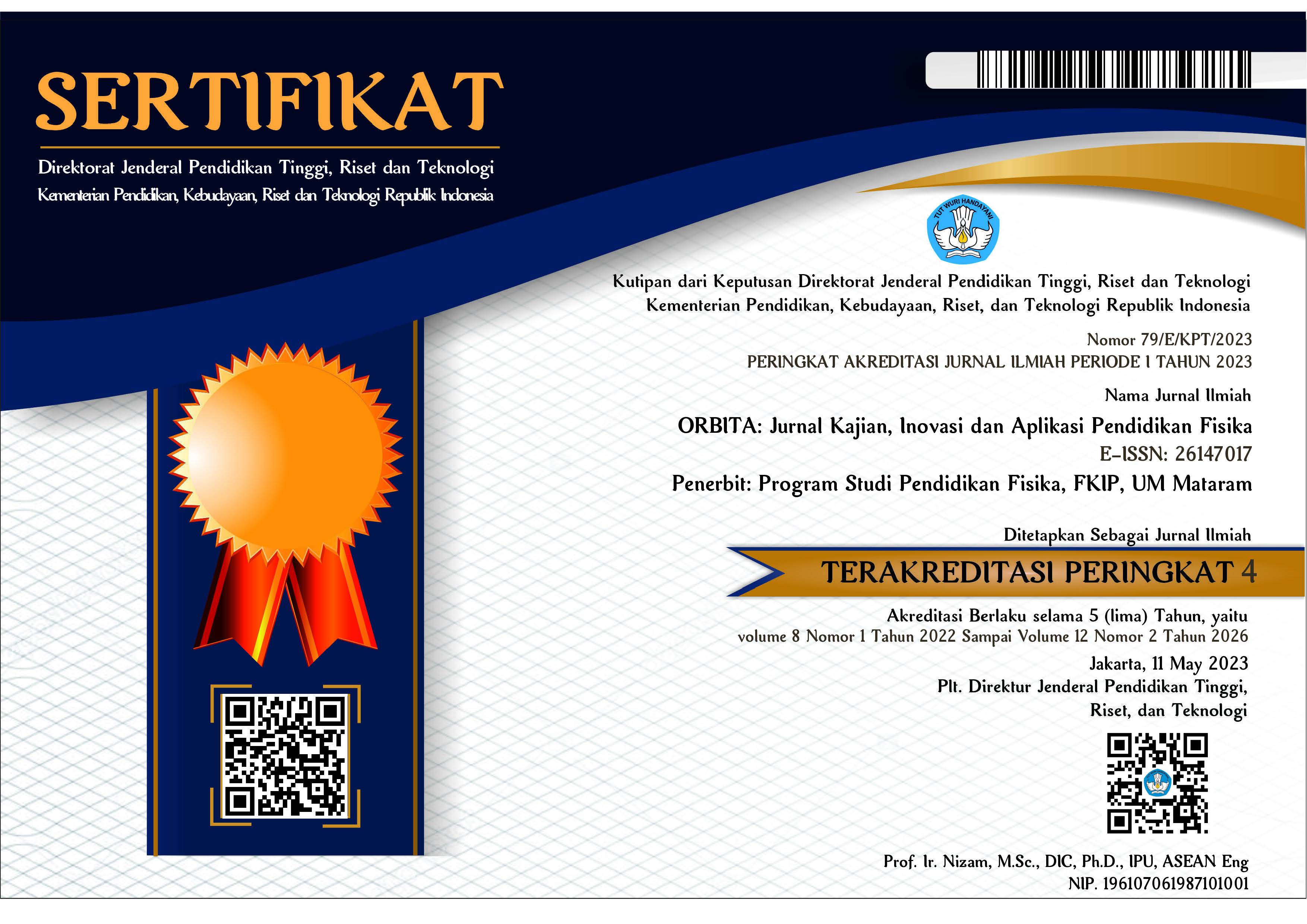PENCITRAAN PEMETAAN PANAS PENYERAPAN RADIASI TERAHERTZ (THz) DALAM JARINGAN BIOLOGIS MENGGUNAKAN MODEL SIMULINK-MATLAB
Abstract
ABSTRAK
Radiasi THz memiliki sifat yang membuatnya lebih menarik dan efektif dalam bidang teknik pencitraan biomedis. Hal ini dikarenakan radiasi THz tidak mengionisasi dan merusak jaringan. Penelitian ini menggunakan sampel jaringan biologis sapi yaitu jaringan kulit, lemak, tumor dan otot. Tujuan dari penelitian untuk mengetahui suatu jaringan terindikasi abnormal atau normal dengan melihat pemetaan panas yang dihasilkan dari penyerapan radiasi THz dalam jaringan biologis sapi dengan cara pemodelan. Penelitian ini menggunakan teknik komputasi biofisik dengan medel simulink-matlab. Rentang frekuensi radiasi THz yang digunakan 0,1 - 1 THz, daya 50 – 150 mW serta kerapatan daya 5 - 25 mW/mm3. Rasio dan temperatur dari masing-masing jaringan yaitu lemak 0,25 T/25 oC (T = 6,25 oC ), kulit 0,432 T/25oC (10,8 oC), otot 0,675 T/25oC (16,88 oC) dan Tumor 0,9 T/25oC (22,50 oC). Hasil penelitian menunjukkan bahwa Jaringan lemak memiliki produksi panas yang lebih kecil dan temperatur yang lebih rendah dari jaringan kulit dan otot. Hal ini dikarenakan jaringan lemak memiliki kadar air yang tinggi dengan konsentrasi yang lebih encer sehingga radiasi THz lebih banyak terserap dengan energi yang lebih cepat habis sesuai penetrasi jaringan.
Kata kunci: terahertz; pemetaan panas; jaringan biologis; simulink-matlab.
ABSTRACT
Terahertz (THz) radiation has properties that make it more attractive and effective in the field of biomedical imaging techniques. This is because THz radiation does not ionize and damage tissue. This study used a sample of bovine biological tissue, namely skin, fat, tumor and muscle tissue. The aim of this research is to find out whether a tissue is indicated as abnormal or normal by looking at the heat mapping generated from the absorption of THz radiation in the biological tissue of cattle by means of modeling. This study uses biophysical computation techniques with the simulink-matlab method. The range of THz radiation frequency used is 0.1 - 1 THz, power 50 - 150 mW and power density 5 - 25 mW / mm3. The ratio and temperature of each tissue were fat 0.25 T / 25 oC (T = 6.25 oC), skin 0.432 T / 25oC (10.8 oC), muscle 0.675 T / 25oC (16.88 oC) and Tumor 0.9 T / 25oC (22.50 oC). The results showed that fat tissue has less heat production and a lower temperature than skin and muscle tissue. This is because the fat tissue has a high water content with a more dilute concentration so that more THz radiation is absorbed with energy that runs out faster according to tissue penetration.
Keywords: terahertz; heat mapping; biological networks; simulink-matlab.
Keywords
Full Text:
PDFReferences
Aurégan, J. C. et al. (2018) ‘Correlation between skin and bone parameters in women with postmenopausal osteoporosis: A systematic review’, EFORT Open Reviews, 3(8), pp. 449–460. doi: 10.1302/2058-5241.3.160088.
Betzalel, N., Feldman, Y. and Ishai, P. Ben (2017) ‘The Modeling of the Absorbance of Sub-THz Radiation by Human Skin’, IEEE Transactions on Terahertz Science and Technology, 7(5), pp. 521–528. doi: 10.1109/TTHZ.2017.2736345.
Chen, H. et al. (2013) ‘The diagnosis of human liver cancer by using THz fiber-scanning near-field imaging’, Chinese Physics Letters, 30(3), pp. 2–4. doi: 10.1088/0256-307X/30/3/030702.
Dewi, R. and Hamdi, M. (2019) ‘PENCITRAAN TERMAL TERHADAP PEMETAAN RADIASI’, 1(1), pp. 11–21.
Fitzgerald, A. J. et al. (2003) ‘Catalogue of human tissue optical properties at terahertz frequencies’, Journal of Biological Physics, 29(2–3), pp. 123–128. doi: 10.1023/A:1024428406218.
Haemmerich, D. et al. (2006) ‘In vitro measurements of temperature-dependent specific heat of liver tissue’, Medical Engineering and Physics, 28(2), pp. 194–197. doi: 10.1016/j.medengphy.2005.04.020.
Handayani, M., Tambunan, W. and Hamdi, M. (2018) ‘ANALISIS KONDUKSI TERMAL JARINGAN SAPI DALAM INTERVAL’, 3(2), pp. 21–24.
Kim, A. D. (2004) ‘Transport theory for light propagation in biological tissue: erratum’, Journal of the Optical Society of America A, 21(8), p. 1585. doi: 10.1364/josaa.21.001585.
Malik, U. et al. (2018) ‘Heat transfer and mapping of THz radiation absorption in biological tissue using Mathematica based Simulink transform’, Malaysian Journal of Fundamental and Applied Sciences, 14(4), pp. 500–508. doi: 10.11113/mjfas.v14n4.1074.
Malik, U. and Hamdi, M. (2015) ‘PREDIKSI TRANSFER PANAS RADIASI TERAHERTZ DALAM ANALOG SNF2015-V-45 SNF2015-V-46’, IV, pp. 45–50.
Malik, U. and Pekanbaru, K. B. (2017) ‘PEMODELAN SATU SIKLUS RADIASI GELOMBANG TERAHERTZ’, (April), pp. 1011–1017.
Nishikawa, K. and Maruani, J. (2013) Quantum Systems in Chemistry and Physics: Progress in Methods and Applications.
Pickwell-MacPherson, E. and Wallace, V. P. (2009) ‘Terahertz pulsed imaging-A potential medical imaging modality?’, Photodiagnosis and Photodynamic Therapy, 6(2), pp. 128–134. doi: 10.1016/j.pdpdt.2009.07.002.
Road, S. and Kingdom, U. (2016) ‘Version of attached le : Catalogue of Human Tissue Optical Properties at’, 44(June), pp. 0–6.
Sadegh, I. and Transition, J. (2017) ‘Transition of diatomic molecular oscillator process in THz region’, (2010), p. 24382.
Shiraga, K. et al. (2014) ‘Characterization of dielectric responses of human cancer cells in the terahertz region’, Journal of Infrared, Millimeter, and Terahertz Waves, 35(5), pp. 493–502. doi: 10.1007/s10762-014-0067-y.
Truong, B. C. Q. et al. (2018) ‘Concentration analysis of breast tissue phantoms with terahertz spectroscopy’, Biomedical Optics Express, 9(3), p. 1334. doi: 10.1364/boe.9.001334.
Usman, M., Okta, T. and Tambunan, W. (2017) ‘JARINGAN BIOLOGI PADA SAPI’, 3(November), pp. 23–26.
Yang, D. et al. (2007) ‘Expanding the bioheat equation to include tissue internal water evaporation during heating’, IEEE Transactions on Biomedical Engineering, 54(8), pp. 1382–1388. doi: 10.1109/TBME.2007.890740.
Yu, C. et al. (2012) ‘The potential of terahertz imaging for cancer diagnosis: A review of investigations to date.’, Quantitative imaging in medicine and surgery, 2(1), pp. 33–45. doi: 10.3978/j.issn.2223-4292.2012.01.04.
DOI: https://doi.org/10.31764/orbita.v6i2.3262
Refbacks
- There are currently no refbacks.

This work is licensed under a Creative Commons Attribution-ShareAlike 4.0 International License.
______________________________________________________
ORBITA: Jurnal Pendidikan dan Ilmu Fisika
p-ISSN 2460-9587 || e-ISSN 2614-7017
This work is licensed under a Creative Commons Attribution-ShareAlike 4.0 International License.
EDITORIAL OFFICE:


























